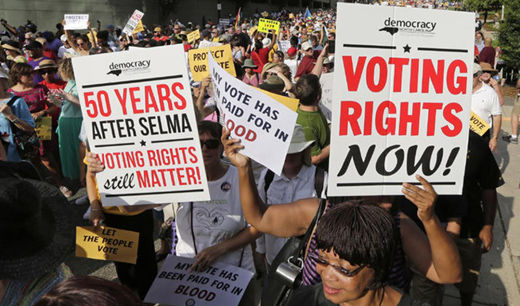
WASHINGTON – Fifty years ago today, thanks to a mass movement started by African American veterans of World War II, the Voting Rights Act was signed into law. From day one, right-wing attorneys, backed by right-wing lawmakers funded by some powerful corporate interests, sought to undermine it. They finally succeeded by taking over the Supreme Court.
The same Court that in 2010 gave to corporations the rights of citizens, in 2013 took the exercise of those rights away from millions of citizens by gutting key provisions of the Voting Rights Act.
Today, once again, there is a mass movement aimed at guaranteeing that all citizens can exercise a right that is theirs by law: the right to vote. This guarantee will be much more difficult to secure than it was in 1965 because bias against minority voters is better hidden. However, the mass movement of today seems up to the job.
Between 1961 and 1965, I was a civil rights organizer, first in Georgia and then in Mississippi.
If you were black and tried to register, chances are you would be fired if you worked for a white person (which most African Americans did). If you were a tenant farmer, you could be put off your land. The homes of many people who tried to register were burned down or shot up by “night riders.”
Between 1961 and 1966 (even after Voting Rights Act passed) eight people were killed in Mississippi alone for leading the fight for the right to vote: Herbert Lee, Medgar Evers, Louis Allen, Andy Goodman, Micky Schwerner, James Chaney, Wayne Yancey, and Vernon Dahmer.
Yet, Southern African Americans were convinced that the key to improving their standard of living was to be able to vote into office people who truly represented them. En masse, despite the danger, black people had the courage to try to try to register to vote. Very few succeeded, however.
To “qualify” to vote in Mississippi, for instance, you had to pass a so-called “literacy test.” You had to interpret to the satisfaction of the county registrar a section of the state constitution chosen by the registrar. If you were black, the registrars were rarely, if ever, “satisfied.”
The Kennedy Administration did virtually nothing to protect black Southerners’ right to vote, and neither, at first, did President Johnson. The Civil Rights Movement was rebuffed by the Democratic Party (the Dixiecrats) that ruled the South, but it continued to grow and gain recognition world wide.
President Johnson came to fight for and eventually sign the Voting Rights Act of 1965 because he saw hundreds of thousands of people in motion demanding action.
The Act outlawed literacy tests and other gimmicks that were used only to prevent African Americans from voting. Section 5 of the Act required that voting jurisdictions with proven patterns of discrimination had to seek federal government approval before changing any voting standards or procedures. Section 4 established a formula to measure patterns of discrimination. Other sections, like Section 2, simply reinforced the principle that the federal government can enforce the right of citizens to have equal access to the ballot.
Many states recognized that lower income voters, who are disproportionately black and Latino, face difficulties in registering to vote and voting. They work longer hours than wealthier people, have less flexibility in their schedules, are less mobile and face language barriers. Therefore, states took measures such as extending registration and voting periods, expanding the sites where people can register, making absentee voting easier and requiring bi-lingual voting materials.
Acting on all fronts
Meanwhile, since 1965 corporate America has been acting on all fronts to gain greater control. One effort has been to try to suppress the voting rights of people who might vote against those who were attacking union rights and public schools, pushing privatization of social programs, shrinking workers’ pensions. For example, as a young law clerk the future Chief Justice of the Supreme Court, John Roberts, was drafting stratagems for undermining the Voting Rights Act.
Since 1965, pro-corporate representatives gerrymandered voting districts to shut out minorities, instituted court cases maintaining the Voting Rights Act discriminated against white people and tried to pass stringent voter ID laws. Many of these efforts failed.
Failed, that is, until right wing Republicans gained control of over 20 state legislatures. Then there was a flurry of successful voter suppression measures, and a massive right-wing propaganda campaign that convinced many Americans that our country has a “voter fraud” problem. It does not.
The culmination came on June 25, 2013. The Supreme Court ruled in favor of anti-voter actions taken by Shelby County, Alabama. In that ruling, the Supreme Court threw out the “formula” section of the Voting Rights Act, which nullified the requirement that states obtain federal approval for changes in voting procedures.
From almost the day after the ruling, state after state passed voter suppression laws. These include putting limitations on early voting, ending registration at motor vehicle departments and instituting strict voter ID requirements, even though studies show that minorities and the working poor have more difficulties in obtaining the required documents.
When I was working in the South, those enforcing state voter registration laws were very clear about their purpose. They stated plainly that blacks should not be allowed. They said that blacks “lacked the intelligence” or “the moral character” of whites.
Today, those who push voter suppression laws claim they are “color blind.” Anybody who can vote during the restricted hours is welcome to do so, they say, no matter what their race. Never mind that the working poor can’t get off from their jobs to accommodate the voting hours.
Rev.William Barber, the president of the North Carolina NAACP often says, “When I’m asked is the problem in this country race or class, I say: ‘yes.'”
Years ago, the North Carolina state legislature passed stringent a voter suppression law that was vetoed by the governor at the time. Then the governor changed, the Supreme Court handed down its Shelby decision, and the North Carolina legislature passed an even more repressive law.
It is becoming clear to hundreds of thousands of people in North Carolina and elsewhere that neither the courts nor legislatures alone can be relied upon to protect voter rights. Legislatures can craft laws to get around court decisions, and courts, such as the U.S. Supreme Court, can kill voter protection measures passed by the states.
That is why, along with taking the state of North Carolina to court to try to get its voter suppression law annulled, hundreds of thousands of people demonstrate weekly at the state Capitol.
It took a mass movement to get the 2015 Voting Rights Act passed, and it will take sustained mass movements to win back the rights stolen by the Supreme Court.
For a history of pre-2013 attempts to undermine the Voting Rights Act, see Inside the 50-year campaign to roll back the Voting Rights Act, by Jim Rutenberg, New York Times Magazine.
For a list of voter suppression laws, see Voter Suppression: How Bad? (Pretty Bad), by Wendy R. Weiser, The American Prospect magazine.
Photo: Chuck Burton/AP











Comments